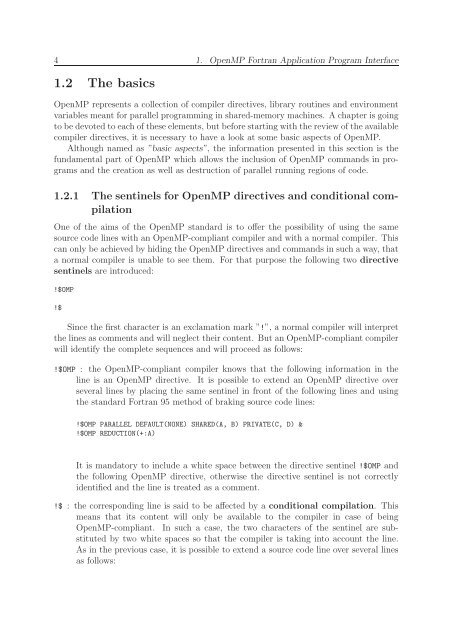Parallel Programming in Fortran 95 using OpenMP - People
Parallel Programming in Fortran 95 using OpenMP - People
Parallel Programming in Fortran 95 using OpenMP - People
Create successful ePaper yourself
Turn your PDF publications into a flip-book with our unique Google optimized e-Paper software.
4 1. <strong>OpenMP</strong> <strong>Fortran</strong> Application Program Interface<br />
1.2 The basics<br />
<strong>OpenMP</strong> represents a collection of compiler directives, library rout<strong>in</strong>es and environment<br />
variables meant for parallel programm<strong>in</strong>g <strong>in</strong> shared-memory mach<strong>in</strong>es. A chapter is go<strong>in</strong>g<br />
to be devoted to each of these elements, but before start<strong>in</strong>g with the review of the available<br />
compiler directives, it is necessary to have a look at some basic aspects of <strong>OpenMP</strong>.<br />
Although named as ”basic aspects”, the <strong>in</strong>formation presented <strong>in</strong> this section is the<br />
fundamental part of <strong>OpenMP</strong> which allows the <strong>in</strong>clusion of <strong>OpenMP</strong> commands <strong>in</strong> programs<br />
and the creation as well as destruction of parallel runn<strong>in</strong>g regions of code.<br />
1.2.1 The sent<strong>in</strong>els for <strong>OpenMP</strong> directives and conditional compilation<br />
One of the aims of the <strong>OpenMP</strong> standard is to offer the possibility of us<strong>in</strong>g the same<br />
source code l<strong>in</strong>es with an <strong>OpenMP</strong>-compliant compiler and with a normal compiler. This<br />
can only be achieved by hid<strong>in</strong>g the <strong>OpenMP</strong> directives and commands <strong>in</strong> such a way, that<br />
a normal compiler is unable to see them. For that purpose the follow<strong>in</strong>g two directive<br />
sent<strong>in</strong>els are <strong>in</strong>troduced:<br />
!$OMP<br />
!$<br />
S<strong>in</strong>ce the first character is an exclamation mark ”!”, a normal compiler will <strong>in</strong>terpret<br />
the l<strong>in</strong>es as comments and will neglect their content. But an <strong>OpenMP</strong>-compliant compiler<br />
will identify the complete sequences and will proceed as follows:<br />
!$OMP : the <strong>OpenMP</strong>-compliant compiler knows that the follow<strong>in</strong>g <strong>in</strong>formation <strong>in</strong> the<br />
l<strong>in</strong>e is an <strong>OpenMP</strong> directive. It is possible to extend an <strong>OpenMP</strong> directive over<br />
several l<strong>in</strong>es by plac<strong>in</strong>g the same sent<strong>in</strong>el <strong>in</strong> front of the follow<strong>in</strong>g l<strong>in</strong>es and us<strong>in</strong>g<br />
the standard <strong>Fortran</strong> <strong>95</strong> method of brak<strong>in</strong>g source code l<strong>in</strong>es:<br />
!$OMP PARALLEL DEFAULT(NONE) SHARED(A, B) PRIVATE(C, D) &<br />
!$OMP REDUCTION(+:A)<br />
It is mandatory to <strong>in</strong>clude a white space between the directive sent<strong>in</strong>el !$OMP and<br />
the follow<strong>in</strong>g <strong>OpenMP</strong> directive, otherwise the directive sent<strong>in</strong>el is not correctly<br />
identified and the l<strong>in</strong>e is treated as a comment.<br />
!$ : the correspond<strong>in</strong>g l<strong>in</strong>e is said to be affected by a conditional compilation. This<br />
means that its content will only be available to the compiler <strong>in</strong> case of be<strong>in</strong>g<br />
<strong>OpenMP</strong>-compliant. In such a case, the two characters of the sent<strong>in</strong>el are substituted<br />
by two white spaces so that the compiler is tak<strong>in</strong>g <strong>in</strong>to account the l<strong>in</strong>e.<br />
As <strong>in</strong> the previous case, it is possible to extend a source code l<strong>in</strong>e over several l<strong>in</strong>es<br />
as follows:
















